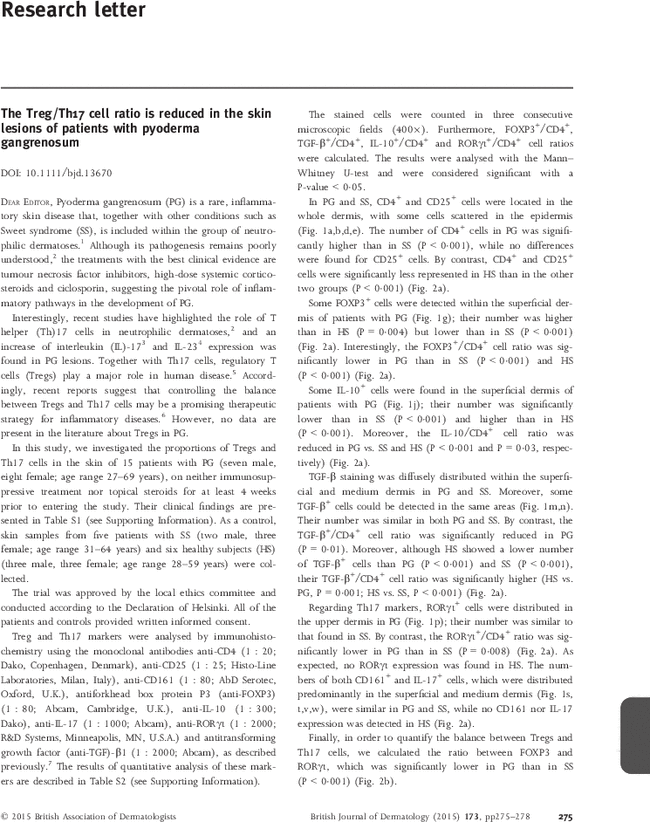The Treg/Th17 cell ratio is reduced in the skin lesions of patients with pyoderma gangrenosum
M. Caproni
Department of Surgery and Translational Medicine, Section of Dermatology, University of Florence, Viale Michelangelo 41, 50125 Florence, Italy
Search for more papers by this authorCorresponding Author
E. Antiga
Department of Surgery and Translational Medicine, Section of Dermatology, University of Florence, Viale Michelangelo 41, 50125 Florence, Italy
Correspondence: Emiliano Antiga.
E-mail: [email protected]
Search for more papers by this authorW. Volpi
Department of Surgery and Translational Medicine, Section of Dermatology, University of Florence, Viale Michelangelo 41, 50125 Florence, Italy
Search for more papers by this authorA. Verdelli
Department of Surgery and Translational Medicine, Section of Dermatology, University of Florence, Viale Michelangelo 41, 50125 Florence, Italy
Search for more papers by this authorL. Venegoni
Dipartimento di Fisiopatologia Medico-Chirurgica e dei Trapianti, Unità Operativa di Dermatologia, IRCCS Fondazione Ca’ Granda, Ospedale Maggiore Policlinico, Università degli Studi di Milano, Milan, Italy
Search for more papers by this authorP. Quaglino
Department of Biomedical Sciences and Human Oncology, 1st Dermatologic Clinic, University of Turin, Turin, Italy
Search for more papers by this authorP. Fabbri
Department of Surgery and Translational Medicine, Section of Dermatology, University of Florence, Viale Michelangelo 41, 50125 Florence, Italy
Search for more papers by this authorA.V. Marzano
Dipartimento di Fisiopatologia Medico-Chirurgica e dei Trapianti, Unità Operativa di Dermatologia, IRCCS Fondazione Ca’ Granda, Ospedale Maggiore Policlinico, Università degli Studi di Milano, Milan, Italy
Search for more papers by this authorM. Caproni
Department of Surgery and Translational Medicine, Section of Dermatology, University of Florence, Viale Michelangelo 41, 50125 Florence, Italy
Search for more papers by this authorCorresponding Author
E. Antiga
Department of Surgery and Translational Medicine, Section of Dermatology, University of Florence, Viale Michelangelo 41, 50125 Florence, Italy
Correspondence: Emiliano Antiga.
E-mail: [email protected]
Search for more papers by this authorW. Volpi
Department of Surgery and Translational Medicine, Section of Dermatology, University of Florence, Viale Michelangelo 41, 50125 Florence, Italy
Search for more papers by this authorA. Verdelli
Department of Surgery and Translational Medicine, Section of Dermatology, University of Florence, Viale Michelangelo 41, 50125 Florence, Italy
Search for more papers by this authorL. Venegoni
Dipartimento di Fisiopatologia Medico-Chirurgica e dei Trapianti, Unità Operativa di Dermatologia, IRCCS Fondazione Ca’ Granda, Ospedale Maggiore Policlinico, Università degli Studi di Milano, Milan, Italy
Search for more papers by this authorP. Quaglino
Department of Biomedical Sciences and Human Oncology, 1st Dermatologic Clinic, University of Turin, Turin, Italy
Search for more papers by this authorP. Fabbri
Department of Surgery and Translational Medicine, Section of Dermatology, University of Florence, Viale Michelangelo 41, 50125 Florence, Italy
Search for more papers by this authorA.V. Marzano
Dipartimento di Fisiopatologia Medico-Chirurgica e dei Trapianti, Unità Operativa di Dermatologia, IRCCS Fondazione Ca’ Granda, Ospedale Maggiore Policlinico, Università degli Studi di Milano, Milan, Italy
Search for more papers by this author
Supporting Information
| Filename | Description |
|---|---|
| bjd13670-sup-0001-TableS1-S2.docWord document, 73 KB | Table S1. Clinical findings in 15 patients with pyoderma gangrenosum. Table S2. Quantitative analysis of the numbers of positive cells per field (400×) in skin lesions of patients with pyoderma gangrenosum and Sweet syndrome, and in healthy subjects as assessed by immunohistochemistry. |
Please note: The publisher is not responsible for the content or functionality of any supporting information supplied by the authors. Any queries (other than missing content) should be directed to the corresponding author for the article.
References
- 1Marzano AV, Ishak RS, Saibeni S et al. Autoinflammatory skin disorders in inflammatory bowel diseases, pyoderma gangrenosum and Sweet's syndrome: a comprehensive review and disease classification criteria. Clin Rev Allergy Immunol 2013; 45: 202–10.
- 2Butler D, Shinkai K. What do autoinflammatory syndromes teach about common cutaneous diseases such as pyoderma gangrenosum? A commentary. Dermatol Clin 2013; 31: 427–35.
- 3Marzano AV, Cugno M, Trevisan V et al. Role of inflammatory cells, cytokines and matrix metalloproteinases in neutrophil-mediated skin diseases. Clin Exp Immunol 2010; 162: 100–7.
- 4Guenova E, Teske A, Fehrenbacher B et al. Interleukin 23 expression in pyoderma gangrenosum and targeted therapy with ustekinumab. Arch Dermatol 2011; 147: 1203–5.
- 5Buckner JH. Mechanisms of impaired regulation by CD4+ CD25+ FOXP3+ regulatory T cells in human autoimmune diseases. Nat Rev Immunol 2010; 10: 849–59.
- 6Niu YH, Yin DL, Liu HL et al. Restoring the Treg cell to Th17 cell ratio may alleviate HBV-related acute-on-chronic liver failure. World J Gastroenterol 2013; 19: 4146–54.
- 7Caproni M, Torchia D, Antiga E et al. The comparative effects of tacrolimus and hydrocortisone in adult atopic dermatitis: an immunohistochemical study. Br J Dermatol 2007; 156: 312–19.
- 8Caproni M, Torchia D, Antiga E et al. The effects of tacrolimus ointment on regulatory T lymphocytes in atopic dermatitis. J Clin Immunol 2006; 26: 370–5.
- 9Antiga E, Quaglino P, Bellandi S et al. Regulatory T cells in the skin lesions and blood of patients with systemic sclerosis and morphoea. Br J Dermatol 2010; 162: 1056–63.
- 10Glocker EO, Kotlarz D, Boztug K et al. Inflammatory bowel disease and mutations affecting the interleukin-10 receptor. N Engl J Med 2009; 361: 2033–45.
- 11Demidowich AP, Freeman AF, Kuhns DB et al. Brief report: genotype, phenotype, and clinical course in five patients with PAPA syndrome (pyogenic sterile arthritis, pyoderma gangrenosum, and acne). Arthritis Rheum 2012; 64: 2022–7.
- 12Marzano AV, Fanoni D, Antiga E et al. Expression of cytokines, chemokines and other effector molecules in two prototypic autoinflammatory skin diseases, pyoderma gangrenosum and Sweet's syndrome. Clin Exp Immunol 2014; 178: 48–56.
- 13Agarwal S, Misra R, Aggarwal A. Interleukin 17 levels are increased in juvenile idiopathic arthritis synovial fluid and induce synovial fibroblasts to produce proinflammatory cytokines and matrix metalloproteinases. J Rheumatol 2008; 35: 515–19.
- 14Goldminz AM, Botto NC, Gottlieb AB. Severely recalcitrant pyoderma gangrenosum successfully treated with ustekinumab. J Am Acad Dermatol 2012; 67: e237–8.
- 15Eastaff-Leung N, Mabarrack N, Barbour A et al. Foxp3+ regulatory T cells, Th17 effector cells, and cytokine environment in inflammatory bowel disease. J Clin Immunol 2010; 30: 80–9.




